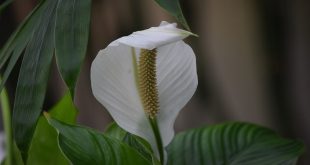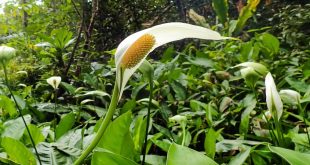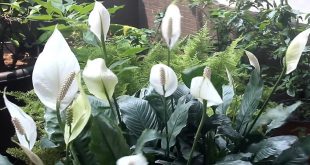Are your peace lilies growing lush green leaves but failing to produce those beautiful white flowers? Don’t worry, this is a common problem faced by many peace lily owners. There are several reasons why your peace lilies may not be blooming as expected.
We will explore the main factors that can lead to a lack of blooms in peace lilies.
Lack Of Sufficient Light
- Peace lilies thrive in bright, indirect light. Insufficient light can hinder their ability to produce flowers.
- Place your peace lily near a window where it can receive bright, filtered light throughout the day.
- If natural light is not available, you can use artificial lights, such as fluorescent bulbs, to provide the necessary light for your peace lily.
- Avoid placing your peace lily in direct sunlight, as this can scorch the leaves and prevent blooming.
Incorrect Watering Practices
- Overwatering or underwatering can disrupt the blooming process of peace lilies.
- Peace lilies prefer evenly moist soil, but they do not tolerate waterlogged conditions.
- Check the moisture level of the soil regularly and water your peace lily when the top inch of soil feels dry.
- Avoid letting the soil dry out completely or become waterlogged.
- Always use room temperature water and avoid using water that contains high levels of chlorine or other chemicals.
Inadequate Fertilization
- Peace lilies require regular fertilization to support their growth and encourage blooming.
- Use a balanced houseplant fertilizer and dilute it to half the recommended strength.
- Feed your peace lily once every two to four weeks during the growing season (spring and summer).
- Reduce the frequency of fertilization during the dormant period (fall and winter).
- Avoid over-fertilization, as this can lead to salt buildup in the soil and cause damage to the plant.
By addressing these common issues related to light, watering, and fertilization, you can help your peace lilies reach their full blooming potential. Remember to provide sufficient light, water your plants correctly, and fertilize them regularly. With proper care, your peace lilies will reward you with their stunning flowers, adding beauty and tranquility to your indoor space.
Insufficient Light: The Main Culprit
Peace lilies are popular houseplants known for their lush green leaves and delicate white flowers. However, if your peace lily is growing leaves but refuses to bloom, insufficient light may be the main culprit. Understanding the light requirements of these plants is crucial for their proper growth and flowering.
Ideal Lighting Conditions For Flowering
Peace lilies thrive in bright, indirect light, mimicking the conditions they would experience in their natural habitat in tropical rainforests. For optimal flowering, they require:
- Moderate to bright indirect light: A balance between too much direct sunlight and complete shade is essential.
- Consistent light: Peace lilies prefer stable lighting conditions without drastic changes or fluctuations in light intensity.
- Proper duration: At least 12-14 hours of light per day is recommended for peace lilies to promote flowering.
Signs Of Insufficient Light In Peace Lilies
If your peace lily isn’t getting enough light, it will exhibit several signs of stress, including:
- Lack of flowers: The most obvious indication of insufficient light is the absence of flowers. Peace lilies require adequate light to produce blooms.
- Slow growth: Insufficient light can hinder the growth of peace lilies, resulting in stunted or leggy plants.
- Pale leaves: If the leaves of your peace lily appear pale or yellowish, it may be a sign that the plant isn’t receiving enough light to photosynthesize properly.
- Drooping foliage: Peace lilies may experience wilted or drooping foliage if they aren’t getting the required amount of light.
How To Improve Lighting For Your Plant
To help your peace lily receive the right amount of light and encourage flowering, consider the following tips:
- Move your plant: If your peace lily is in a low-light area, relocate it to a brighter spot, but away from direct sunlight.
- Adjust light exposure: If your peace lily is exposed to direct sunlight, move it to a spot with filtered or indirect light.
- Rotate the plant: Regularly rotate your peace lily to ensure all sides receive equal light exposure, preventing it from leaning or stretching towards the light source.
- Supplement with artificial light: If natural light is limited, use artificial light sources, such as full-spectrum grow lights, to supplement the light requirements of your peace lily.
By ensuring your peace lily gets the right amount of light, you can create an ideal environment for it to bloom and thrive. So, provide your plant with the appropriate lighting conditions and watch as it rewards you with its elegant, white flowers.
Watering Woes: Finding The Right Balance
Peace lilies are beautiful houseplants that can add a touch of elegance to any indoor space. However, it can be frustrating when your peace lilies are flourishing with leaves but fail to produce blooms. One of the most common reasons for this is improper watering.
Finding the right balance in watering your peace lilies is essential for encouraging the growth of vibrant, beautiful flowers. Let’s explore the correct watering techniques and the impact of both overwatering and underwatering on the flowering process.
Correct Watering Techniques For Peace Lilies:
- Peace lilies prefer to be slightly moist rather than completely soaked or bone dry.
- Water the plant thoroughly, allowing the excess water to drain from the pot.
- Make sure to water the soil evenly, ensuring that all parts receive moisture.
- Consider using room temperature or lukewarm water to avoid shocking the plant’s roots.
Overwatering Troubles And Their Effects:
Overwatering can be detrimental to the health and flowering of your peace lilies. Here are some ways overwatering can hinder their bloom:
- Excess water can lead to root rot and suffocate the plant’s roots, inhibiting their ability to absorb nutrients.
- Overwatered plants may have yellowing leaves, wilting, or a foul smell due to root decay.
- Drainage problems caused by overwatering can result in stagnant water, promoting the growth of harmful fungi and bacteria.
Underwatering And Its Impact On Flowering:
On the other hand, underwatering can also prevent peace lilies from blooming as they should:
- Insufficient moisture can cause the plant to become stressed, forcing it to conserve energy and divert resources away from flowering.
- Underwatered peace lilies may display wilted or drooping leaves, and the soil may become extremely dry.
- Lack of water can disrupt the plant’s overall health, making it more susceptible to diseases and pests.
Tips For Proper Watering To Encourage Blooms:
To ensure your peace lilies blossom to their fullest potential, follow these tips for proper watering:
- Use a well-draining potting mix that allows excess water to flow freely out of the container.
- Touch the soil with your fingers to determine its moisture level before watering. Wait until the top inch of the soil feels slightly dry.
- Consider using a moisture meter to accurately gauge the moisture content of the soil.
- Maintain consistent watering intervals, allowing the soil to dry out slightly between waterings.
- Regularly check the drainage holes and remove any blockages to ensure proper water flow.
By mastering the art of watering, you can provide your peace lilies with ideal conditions for flowering. Remember: too much or too little water can hinder their growth. With the correct watering techniques and a little bit of patience, you can soon enjoy the stunning blooms of your peace lilies.
The Role Of Fertilization: Feeding For Flowers
Peace lilies are known for their lush green foliage, but when it comes to flowering, you may find yourself wondering what you’re doing wrong. The truth is, proper fertilization plays a crucial role in encouraging peace lilies to produce those beautiful blooms.
Let’s dive into the key points about the role of fertilization in feeding for flowers.
Nutrients Essential For Flowering
To promote flower production in peace lilies, it’s important to ensure they have access to the right nutrients. Here are the key nutrients essential for their flowering:
- Nitrogen (N): Nitrogen aids in leaf and stem growth, but too much of it can hinder flower production.
- Phosphorus (P): Phosphorus is crucial for promoting healthy root development and flowering in peace lilies.
- Potassium (K): Potassium enhances the overall health and vigor of peace lilies, allowing them to produce vibrant flowers.
Choosing The Right Fertilizer For Peace Lilies
When it comes to selecting fertilizers for peace lilies, it’s vital to choose one that is tailored to their specific needs. Consider the following points when choosing fertilizers:
- Use a balanced fertilizer: Look for a fertilizer with an npk ratio of 20-20-20 or a similar balanced ratio to ensure the peace lilies receive all the necessary nutrients.
- Slow-release or liquid fertilizer: Both options work well, but slow-release fertilizers cater to the long-term nutritional needs of peace lilies, while liquid fertilizers provide a quick boost.
- Organic vs. Synthetic: While both types of fertilizers can be used, organic ones can help improve soil health and long-term growth.
Frequency And Amount Of Fertilization
Finding the right balance when it comes to fertilization frequency and amount is essential for the optimal growth and flowering of peace lilies. Consider the following guidelines:
- Frequency: Fertilize peace lilies every two to four weeks during the growing season, which typically spans from spring to early fall.
- Dilution: Always dilute liquid fertilizers before applying them to avoid causing harm to the peace lilies’ roots, following the instructions provided by the manufacturer.
- Amount: Apply half the recommended dosage for potted peace lilies to prevent fertilizer burn and adjust based on the plant’s response.
Additional Considerations For Optimal Flower Production
To maximize the flower production of your peace lilies, keep in mind the following additional considerations:
- Lighting: Provide bright, indirect light for peace lilies, as insufficient light can hinder flower formation.
- Watering: Avoid overwatering peace lilies, as excessive moisture can lead to root rot and impact their ability to produce flowers.
- Temperature and humidity: Peace lilies thrive in temperatures between 65-80°f (18-27°c) and prefer slightly higher humidity levels.
- Pruning: Regularly remove yellow or dead leaves and spent flowers to channel the plant’s energy into producing new blooms.
By understanding the role of fertilization and providing your peace lilies with the right nutrients, choosing the appropriate fertilizers, and maintaining a proper fertilization schedule, you can encourage your peace lilies to produce gorgeous flowers that will brighten up your home or office space.
Troubleshooting Common Issues
Peace lilies are popular indoor plants known for their lush green leaves and stunning white flowers. However, if your peace lily is growing plenty of leaves but no flowers, it can be quite disappointing. Don’t worry though, there are several common issues that could be causing this problem, and with a little troubleshooting, you can help your peace lily bloom beautifully.
In this section, we’ll explore some of the most common issues that may be preventing your peace lilies from producing flowers:
Pest Infestations And Their Impact On Blooming
- Spider mites, mealybugs, and other pests can infest peace lilies and affect their ability to flower.
- These pests can damage the leaves and weaken the overall health of the plant, which in turn reduces the energy available for flowering.
- Regularly inspect your peace lily for signs of pests and take appropriate measures to control the infestation.
Temperature And Humidity Concerns
- Peace lilies thrive in temperatures between 65-80°f (18-27°c) and prefer higher humidity levels.
- Extreme temperature fluctuations or low humidity can hinder flower production.
- Keep your peace lily away from drafty windows or doors, and consider using a humidifier or misting the leaves to maintain the ideal humidity levels.
Pot Size And Its Effect On Flowering
- Peace lilies prefer to be slightly root-bound, meaning their roots should fill the pot but not be overly crowded.
- When a peace lily is in a pot that is too large, it focuses on growing foliage rather than flowering.
- If your peace lily is not flowering, consider repotting it into a slightly smaller container to encourage blooming.
Potential Diseases Affecting Peace Lilies Floral Growth
- Certain diseases, such as root rot or fungal infections, can impact a peace lily’s ability to produce flowers.
- These diseases often stem from overwatering or poor drainage, which can lead to root problems.
- Ensure your peace lily is planted in well-draining soil and water it only when the top inch of soil feels dry.
By addressing these common issues and providing the optimal growing conditions for your peace lilies, you can increase the chances of enjoying their beautiful flowers. Keep a close eye on your plants, take preventative measures to avoid pests and diseases, and provide the right temperature, humidity, and pot size.
With a little care and patience, you’ll soon see your peace lilies blossoming with vibrant flowers.
Special Care For Peace Lilies
Do you own a peace lily that seems to be thriving with green leaves, but is stubbornly refusing to produce any flowers? Don’t worry, you’re not alone. Many peace lily owners face the same predicament. While peace lilies are known for their beautiful white flowers, they can be a bit finicky when it comes to blooming.
Fortunately, there are several special care techniques you can employ to encourage your peace lily to blossom. In this section, we will explore these techniques, including division and repotting, seasonal considerations for flowering, pruning and propagation tips, and understanding dormancy periods.
Let’s dive in and discover how to unlock the full potential of your peace lily’s beauty.
Division And Repotting Techniques
- Division involves separating the root ball of a mature peace lily into smaller sections.
- Repotting your peace lily after division helps to rejuvenate the plant and promote flower production.
- Choose a pot with proper drainage and use well-draining soil to ensure optimal growing conditions for your peace lily.
- Remember to water your peace lily appropriately after repotting to prevent stress.
Seasonal Considerations For Flowering
- Peace lilies prefer warm temperatures, ideally between 68-85°f (20-29°c).
- Exposure to direct sunlight should be limited, as it can scorch the leaves and hinder flowering.
- During the summer, consider moving your peace lily outdoors to a shaded area, allowing it to benefit from natural light without being subjected to direct sun.
- In winter, ensure your peace lily is placed in a warm location away from cold drafts or heaters, as extreme temperature fluctuations can negatively impact flowering.
Pruning And Propagation Tips
- Regularly removing yellow or brown leaves and spent flowers will promote overall plant health and encourage new growth.
- Propagating your peace lily through cuttings can be a rewarding way to expand your collection.
- Simply cut a healthy stem below a node and place it in a glass of water or moist soil until roots develop.
- Once roots have formed, transplant the cutting into a new pot and care for it as you would a mature peace lily.
Understanding Dormancy Periods
- Peace lilies have natural dormancy periods during which they may not produce flowers.
- These periods can vary from a few weeks to a couple of months.
- During dormancy, reduce watering and fertilizing, allowing the plant to rest and store up energy for future growth.
- Be patient and continue providing appropriate care, and your peace lily will likely resume flowering once its dormancy period has ended.
By implementing these special care techniques, you can increase the likelihood of your peace lily blooming and enjoying its beautiful flowers. Remember to be consistent in your care routine and provide the ideal growing conditions for your peace lily. With a little patience and tender loving care, you’ll soon be rewarded with a gorgeous display of blooms from your peace lily.
Frequently Asked Questions Of Why Are Your Peace Lilies Growing Leaves But No Flowers?
Why Are My Peace Lilies Not Blooming?
Peace lilies may not bloom due to insufficient light, overwatering, low humidity, or a lack of nutrients. Assess these factors and make necessary adjustments for optimal flowering.
Can I Encourage My Peace Lilies To Bloom?
Yes, you can encourage peace lilies to bloom by providing bright, indirect light, ensuring proper watering (keeping soil moist but not soaking), maintaining humidity (using a pebble tray or misting), and fertilizing occasionally with a balanced houseplant fertilizer.
How Long Does It Take For Peace Lilies To Bloom?
Peace lilies typically take 4 to 6 weeks to bloom after the emergence of new leaves. However, factors like light, temperature, and plant health can influence the timing.
Are Peace Lilies Indoor Or Outdoor Plants?
Peace lilies are commonly grown as indoor plants due to their preference for filtered light and warm temperatures. However, they can be grown outdoors in warm, shaded areas.
What Is The Ideal Temperature For Peace Lily Blooms?
Peace lilies thrive in temperatures between 65-80°f (18-27°c). They may struggle to bloom if the temperature falls below 60°f (15°c) or rises above 90°f (32°c).
Conclusion
If you find your peace lilies are only growing leaves but no flowers, there are several factors to consider. Providing adequate light, in the right intensity and duration, is crucial for these plants to bloom. Overfeeding or underwatering can also inhibit flower production.
Additionally, make sure your peace lily is not exposed to extreme temperature fluctuations or drafts. Proper humidity levels are vital, and misting or placing the plant on a tray of water and pebbles can help maintain humidity. Regularly checking for pests and diseases is essential, as these can affect the plant’s overall health and ability to flower.
By following these guidelines and providing optimal care, you can encourage your peace lilies to bloom and enjoy their stunning flowers. Remember to be patient and consistent in your efforts, as it may take some time for the plant to adjust and produce flowers.
 GardenXpert Garden Advice Blog
GardenXpert Garden Advice Blog





